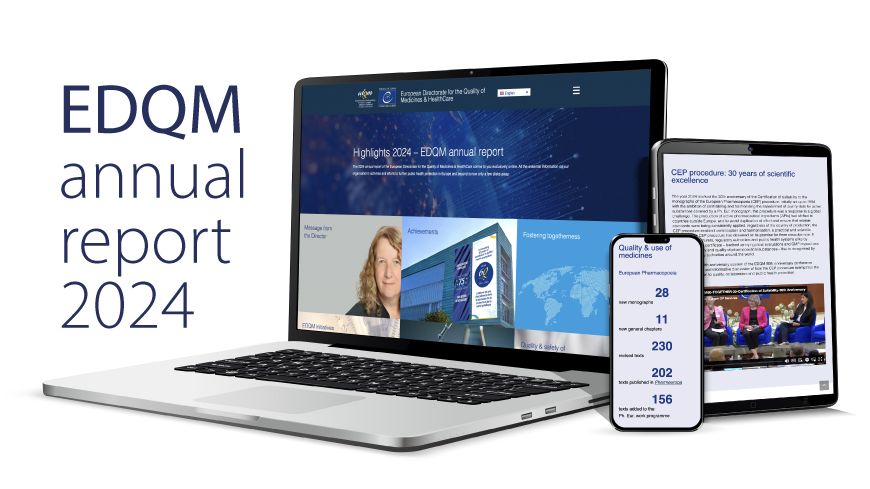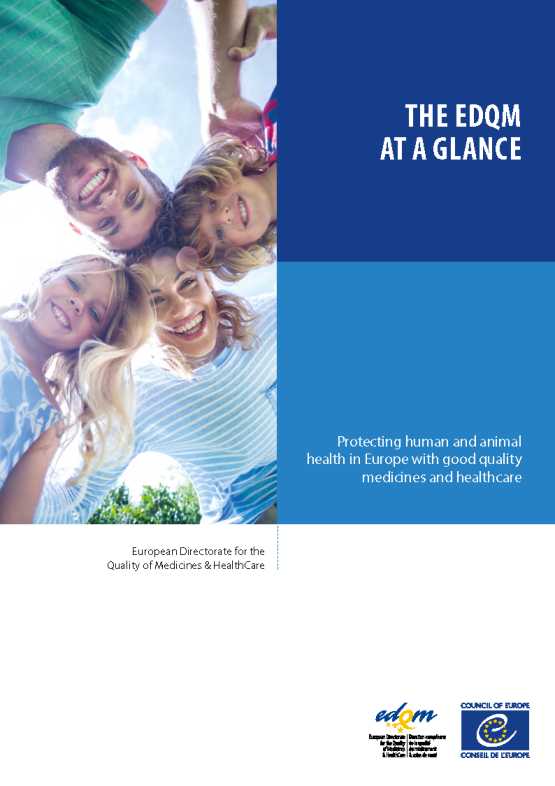History
(working)
2024
Anniversaries defined the EDQM’s year: 60 years of excellence in public health protection since the creation of the European Pharmacopoeia – with an international conference to mark the occasion – and 30 years since the creation of both the Network of Official Medicines Control Laboratories (OMCLs) and the Certification of suitability (CEP) procedure.
The EDQM also continued to look confidently to the future after publishing its Medium-Term Strategy for the period 2024-27. The EDQM’s global outreach and impact continued to grow, confirming this optimism. New co-operation agreements and partnerships were established with important stakeholders like the Brazilian health authority (ANVISA) and the Turkish Medicines and Medical Devices Agency, and the Pharmacopoeial Discussion Group pursued its expansion programme, inviting other world pharmacopoeias to participate in developing harmonised pharmacopoeial standards. The EU regulation on substances of human origin (SoHO), referring to the technical guidelines developed by the EDQM, was adopted, confirming our role as a major player in this field.
(done)
2023
In 2023, the EDQM continued to expand its global outreach, welcoming new observer states to the European Pharmacopoeia Commission (the Kyrgyz Republic and Egypt). Recognising the impact of medicine shortages, the EDQM undertook new initiatives contributing to mitigating this challenge.
The EDQM launched a comprehensive analysis of its environment to devise a new medium-term strategy, which will shape its strategic directions for the next four years (2024 -2027). In addition, it revised its long-term investment strategy, laying down investment plans with a view to ensuring the sustainability of the EDQM’s operation and activities in the long term.
(done)
2022
In 2022, the EDQM’s ability to change, benefit from transition and adapt to new circumstances was crucial to the success of its activities. The EDQM became a Major Administrative Entity within the Council of Europe organisational structure, reporting directly to the Secretary General. Changes in key management personnel were made.
(done)
2021
In 2021, the European Pharmacopoeia Commission adopted more than 200 texts, reference standard availability was ensured at a level of over 99% and the production of reference standards was fully maintained. Two major projects were completed: the real-time remote inspection pilot project ...
(done)
2020
The COVID-19 pandemic marked the year 2020, but the EDQM, operating on the front lines of public health protection, immediately drew up contingency plans for all its branches of activity and continued to fulfil its mission despite the necessary restrictions on travel, shipping and contact ...
(done)
2019
The year 2019 saw important progress in all EDQM activities. The European Pharmacopoeia Commission appointed more than 850 members to its groups of experts and working parties for a new term of office of three years.
(done)
2018
2018 was another productive year for the European Pharmacopoeia (Ph. Eur.) Commission, a testament to its commitment to keeping abreast of new scientific developments and anticipate the need to create standards in some highly complex fields. ...
(done)
2017
The European Pharmacopoeia Commission made major progress in the field of biotherapeutic products and animal protection in 2017.
In particular, the first monograph on a monoclonal antibody (mAb): Infliximab concentrated solution (2928) was adopted, marking an important milestone in relation to biotherapeutic products.
(done)
2016
The year 2016 saw the publication of the 9th edition of the European Pharmacopeia and the election of a new Chair and two new Vice-Chairs to the Ph. Eur. Commission.
The Ph. Eur. Commission also revised its working procedures to open up to nominations for its Groups of Experts and Working Parties to experts from states that are neither members of nor observers to the European Pharmacopeia.
(done)
2015
The Ph. Eur. Commission adopted its first finished product monograph containing a chemically defined active substance and adopted its strategy for the implementation of the ICH Q3D Guideline on Elemental impurities.
(done)
2014
The year 2014 was an anniversary year for the EDQM. It celebrated the 50th anniversary of the Convention on the Elaboration of a European Pharmacopoeia and the 20th anniversaries of both the OMCL Network and of the procedure for Certification of Suitability to the European Pharmacopoeia Monographs.
(done)
2013
The EDQM Laboratory was accredited as ISO/IEC 17025:2005 compliant and the ISO 9001:2008 certification was extended to cover the conduct of laboratory studies. The 8th Edition of the Ph. Eur. came into force and South Africa and the Taiwan Food and Drug Administration (TFDA) were granted observer status to the European Pharmacopoeia Convention.
(done)
2012
The eTACT project, the EDQMs’ anti-counterfeiting traceability service for medicines was launched. Ukraine became the first country to ratify the Medicrime Convention and the 38th Member of the European Pharmacopoeia Convention and the Republic of Guinea and Singapore received observer status.
(done)
2011
On 24 June 2011, the EDQM signed a trilateral Memorandum of Understanding (MoU) with the State Administration of Traditional Chinese Medicine of the People's Republic of China (SATCM) and its National Key Institute of TCM Quality Control (NKI-TCM).
The ISO 9001:2008 certificate was extended ...
(done)
2010
Memorandums of Understanding are signed with the National Institute of Food and Drug Safety Evaluation (NIFDS), Korea Food and Drug Administration, and the Chinese National Institute of Food and Drug Control (NIFDC), respectively.
(done)
2009
The EDQM's assessment and inspection activities within the Procedure for the Certification of Suitability of the Monographs of the European Pharmacopoeia are awarded ISO 9001:2008 certification by the official French standardisation body (Association française de normalisation - Afnor) via Afnor Certification (AFAQ); ...
(done)
2008
The EDQM becomes responsible for co-ordinating activities linking the quality of medicines to the quality and safety of their use in the following fields: the classification of medicines as regards their supply, pharmaceutical practices and care and risk prevention and management of counterfeiting of medical products and similar crimes.
(done)
2007
Memorandums of Understanding are signed with:
- the Pharmaceutical Inspection Cooperation Scheme (PIC/S) to facilitate the exchange of information and collaboration on inspections of manufacturing sites for active pharmaceutical ingredient (APIs) and blood transfusion services; ...
(done)
2006
The EDQM becomes responsible for blood transfusion and organ transplantation activities; the EDQM takes over responsibility for WHO International Standards for Antibiotics (ISA).
(done)
2004
Directives 2001/83/EC and 2001/82/EC are amended by Directives 2004/27/EC and 2004/28/EC respectively legally permitting the EDQM to ask national inspection services to collaborate on inspections of manufacturing and distribution sites for raw materials for pharmaceutical use and legally recognising the role played by the General European Network of OMCLs (GEON) in independent testing.
(done)
2003
Annex 1 of Directive 2001/83/EC is revised and adopted under Directive 2003/63/EC maintaining the mandatory character of European Pharmacopoeia Monographs when requesting marketing authorisation (MA) for medicinal products for human and veterinary use.
(done)
2001
Directives 2001/82/EC and 2001/83/EC on medicines for human and veterinary use are codified to supersede all previous directives; thus maintaining the mandatory character of European Pharmacopoeia Monographs when requesting marketing authorisation.
(done)
1997
A contract is signed with the European Medicines Agency (EMA) allowing a sampling and testing programme for centrally authorised products (CAP).
(done)
1996
The European Directorate for the Quality of Medicines (EDQM) is created.
(done)
1994
The European Union becomes a party to the Convention acting on behalf of its member states for non-technical decisions; a contract is signed between the Commission of the European Union and the Council of Europe's European Pharmacopoeia Secretariat to set up a European network of Official Medicines Control Laboratories (OMCLs); the Procedure for the Certification of Suitability comes into force.
The Council Decision of 16 June 1994 (94/358/EC) accepts, on behalf of the European Community, the Convention on the elaboration of a European Pharmacopoeia.
(done)
1993
A Memo of Understanding is signed with the European Committee for Standardisation (CEN) concerning medical devices.
(done)
1991
A contract is signed between the Commission of the European Communities and the Council of Europe putting the European Pharmacopoeia Secretariat in charge of a biological standardisation ...
(done)
1990
The Pharmacopoeial Discussion Group (PDG) is set up with the United States Pharmacopeia (USP) and the Japanese Pharmacopoeia (JP).
(done)
1989
A Protocol to the Convention on the Elaboration of a European Pharmacopoeia is signed to prepare the way for the European Community to be become a full member.
(done)
1981
Council Directive 81/852/EEC of 28 September 1981 makes compliance with European Pharmacopoeia Monographs mandatory when requesting marketing authorisation for medicines for veterinary use.
(done)
1975
Council Directive 75/318/EEC of 20 May 1975 makes compliance with the European Pharmacopoeia Monographs mandatory when requesting marketing authorisation for medicines for human use.
(done)
1967
The first laboratory is inaugurated making adoption, by the European Pharmacopoeia Commission, of the first texts on general methods for chemical, physical and physico-chemical analysis possible.
(done)
1965 - 1966
The Technical Secretariat is expanded and two vice-Chairs of the Ph. Eur. Commission are appointed.
(done)
1964
On 17 March, the Convention on the Elaboration of a European Pharmacopoeia was adopted by the Committee of Ministers. The first meeting of the Ph. Eur. Commission was held on 28 ...
(done)
1963
On 17 November, the Council of Europe’s Public Health Committee adopted the draft Convention on the establishment of legal, administrative and technical bodies of a European Pharmacopoeia.





